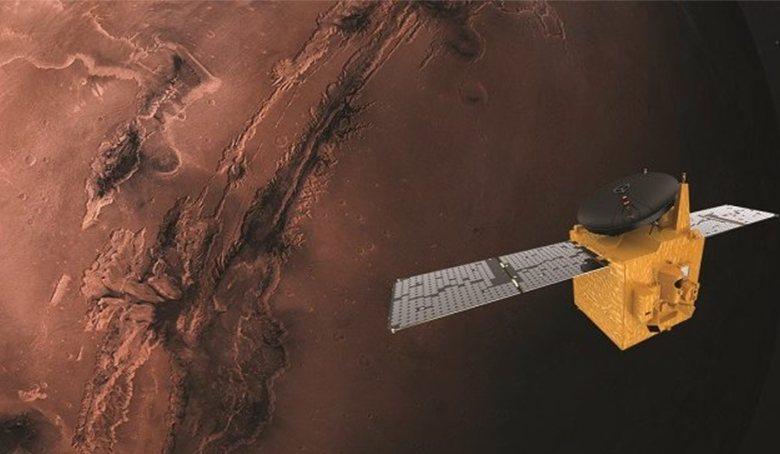The UAE’s first interplanetary exploration mission, the Hope probe, is expecting to enter Mars’ orbit tomorrow (9 February) at about 7.42 pm UAE time (15:42 GMT) following its seven month journey to the Red Planet.
The first of three spacecraft destined to arrive at Mars in the next couple of weeks, the Hope probe is now less than 30 hours away from starting a complex Mars Orbital Insertion (MOI) manoeuvre that, based on the success of past missions, means it has a 50 percent chance of failing.
This critical phase of orbital entry involves reversing the spacecraft and firing the Hope probe’s six Delta-V thrusters in a 27-minute deceleration ‘burn.’
Hope’s six thrusters will deliver some 650 Newtons of thrust during the burn, which is intended to rapidly slow the speed of the spacecraft from 121,000 kilometres per hour (km/h) to 18,000 km/hr.
“This is a heavily rehearsed, designed, tested manoeuvre,” said Sarah Al Amiri, chairperson of the UAE Space Agency and UAE minister of state for advanced technology, during a webinar on 1 February. “But we have never used our thrusters for 27 minutes continuously. We’re going to burn half of our fuel.”
The MOI is set to begin just after 7.30pm UAE time and will commence when the spacecraft is approximately 2,363 kilometres from the planet’s surface.
Hope will reach a final proximity of 1,062 kilometres from Mars, once the burn is complete and mission control staff back on Earth will have to wait a worrying 11 minutes to find out whether the MOI was successful or not.
“Though we have carried out multiple tests and are confident about the manoeuvres we have performed, space exploration always includes an element of risk and we are keenly aware that 50 percent of all missions to Mars have failed,” Omran Sharaf, Project Director of the Emirates Mars Mission, said.
If all goes according to plan, then the UAE will become the fifth country in history to reach Mars - a triumph currently held only by the US, India, the former Soviet Union and the European Space Agency.
Once in its captured orbit, Hope will then take two months to transition to its science orbit, during which time the probe’s instrumentation will be tested as it swings between 1,000 (periapse) to 49,380 (apoapse) kilometres from the martian surface.
The probe is equipped with three instruments to examine Mars’ atmosphere in detail and will monitor, amongst other things, the atmospheric rate of escape of hydrogen and oxygen over one martian year.
It will also study the connection between weather change and atmospheric loss, a process that is thought to be linked to surface corrosion on the Red Planet.
During its mission, the Hope Probe will collect and send back 1 terabyte of new Mars data to the Science Data Center in the UAE.
Once catalogued and analysed by the EMM science team, it will be made available for scientists around the world to study.
“The insights and data we gain from understanding the Martian climate will add new dimensions to human knowledge about how atmospheres work, which will help scientists and researchers evaluate distant worlds for conditions that might support life. Understanding the geographical and climate changes of Mars and the other planets will help us gain deeper insights to find solutions for key challenges facing mankind on earth,” the EMM science team said.
Hot on the heels of Hope is China’s Tianwen-1 spacecraft, which is due to arrive at Mars on 10 February.
Tianwen-1, or "Questions to Heaven”, includes a Mars orbiter, a lander and a solar-powered rover that China hopes to land in a massive impact basin on Mars known as Utopia, in May.
Last but not least is NASA’s Mars 2020 mission. With a so-far 100 percent success rate when it comes to rovers deployed to the martian surface, Mars 2020 is aiming to touchdown its fifth rover, Perseverance, on 18 February. Going one step further than previous rover missions, Perseverance will also be accompanied by a "marscopter", a small winged craft designed to fly as high as 4.5 metres (15 feet) above the ground.
The Mars Helicopter will launch as a technology demonstrator and if it gets off the ground, will be the first autonomous rotorcraft to fly on another planet.











